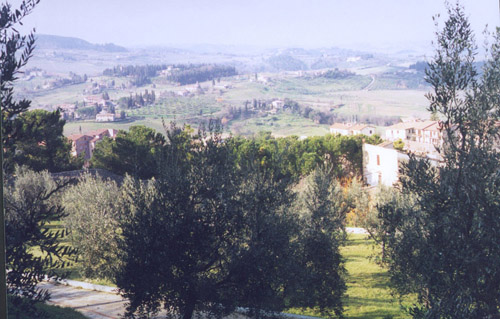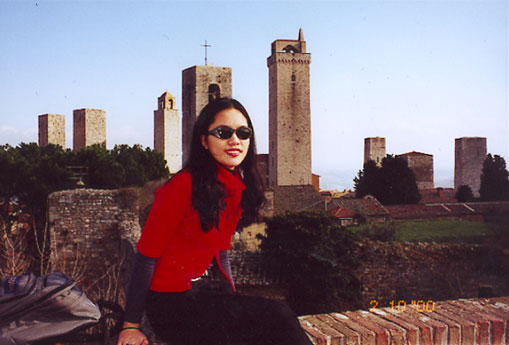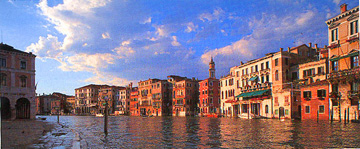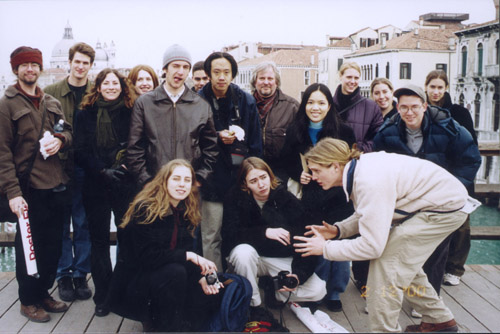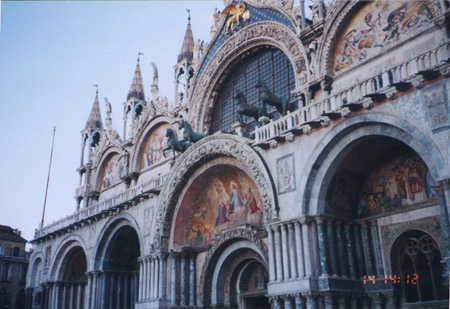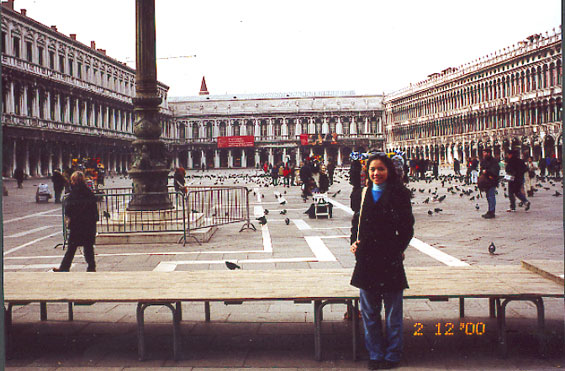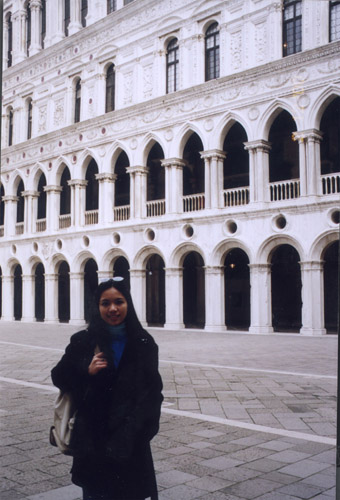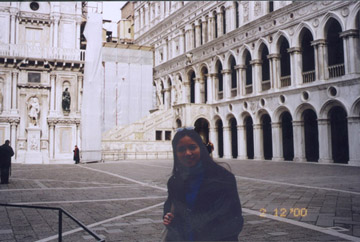

Okay, so I have no money on me. I called up my roommate to help me cancelled my credit card. I tried to get myself an emergency credit card from Italy, but my bank will not approve on sending me a credit card oversea. Ah~! I would slap my bank if it was a person standing in front of me, but I couldn't do anything except borrow money from Bill for the rest of the trip.
I feel bad borrowing money from people. Let me think...the last time I borrowed money from a friend was when I had to make a phone call. I had to borrow 25 cents from my roommate because I only have hundred bill with me. Heck, I always have money with me. The fact that I might not have money with me never crossed my mind!!! Luckily, our class didn't stay in Florence for too long, or else I would go insane for not being able to shop!
We took a day trip to San Gimignano. It is a small town about one hour away from Florence. We got up early in the morning, and went to the bus station to catch a bus. San Gimignano is fairly small. It is surrounded by fields of olive trees and grape vines. There are eleven towers within the city. We spent lunch picnicing on top of a tower. When we first arrived at the town, it struck me as if we had walked back to medieval period! There is a sense of innocent to the style of the architecture. All the buildings are made of bricks. I can almost feel how people hundred years old might have lived. The women fetching water from the well located in the center of the plaza. Young ladies hanging dyed draperies down the towers. The men gathering around the plaza chit-chatting. Everything looks so old, yet settle and peaceful.
I would suggest anyone who goes to San Gimignano to eat before they make a tour at the Medieval Torture Museum. Oh my gosh~ the torture instruments displayed inside the museum are really beyond what I could imagine! There are all types of way where people could be tortured. If one survived the torture, they are proven to be innocent. Although, I doubt anyone could survive any of the tortures executed during medieval period. Even if they do, they probably were already insane or disabled for the rest of their life. For example, there was one where they would tie the victum down and clamp their head to the wall, and drip water on to the top of their head. The result is to drive them mad. Another one is where they would just wall up people! I mean literary! To build a wall around the victum in a small place no bigger than 4 feet square and segregate them from the rest of the world. Leaving only a small opening to pass food to the victum. Imagine! Being locked up in a small, damp and dark room with barely any food! I would go insane! Oh, and there are other really disgusting tools for ripping people's genetical and anus apart. What really made me sick was that these tortures were performed by monks! People that are suppose to be holy and compassion for all beings! How could anyone belonging to God do such...such...things!
Okay, so I finally left Florence and took a train to Venice. Venice is beautiful! It is basically a man made island. Our train seem like running on top of the sea as we approach the city. Looking from far out the sea, the city looks as if though floating on top of the sea. There are no cars in Venice. The only way to get around the city is either riding the waterbus known as "vapporatoes" or walk with your own feet! Of course, there are always the water taxi or the wonderful romantic gondola which you can take, but paying a lot more than the waterbus.
The first day when we arrived at Venice, it was already during the afternoon. The sun was just about to set across the horizon. The sight is beautiful! As the sun ray sprinkled gold across the surface of the ocean, the clouds in the sky is transformed into all sorts of fantasy like colors.
The next day we went to visit San Marco and the Doge's Palace. The Venetians believe that Saint Mark was the gaurdian of the city. The body of Saint Mark is believed to be burried here. Inside San Marco, the entire ceiling is decorated with gold mossaic! The floor are decorated with amazing tile patterns! One of the most characterization of Venezian architecture is the marble door steps at the entrances. These door steps were purposely built to block the invasion of water during high tides or rainy days. There are also many boards layout throughout the plaza of San Marco for people to walk on in case the plaza is flooded with water, which happens very often!
Of all the palaces in Venice, only the Doge's Palace is considered a real "palazzo." Venetians referred to the rest of the palaces as "C?" which stands for "casa" or house. The Doge's Palace was first built in 810 when "Agnello Parteciaco, the first duke of Venice, under pressure from Charlemagne's Franks, transferred the capital of the Venetian dukedom from Malamocco to the Realtine island, on which present-day Venice stands." The Doge's Palace has a complicated history. It was built over a long period, and had been burnt many times. Over the centuries, it was enlarged and extended for different purposes. It incorporated designs from three different periods, the Byzantine, the Gothic and the Renaissance. The palace was one of the best architectures in the history of architecture and its design fully expresses the Venetian culture and the power and wealth of the Republic.
The history of the Doge's Palace is as complex and long as the Venetian Republic government. The Doge's Palace was first chosen for its strategic location and control over the great basin of San Marco. Little is known of its earliest design, except that it was built for a defensive purpose. The populace burned the architecture in 976 along with the basilica for disagreements on political issues. The first determining rebuilding was begun in the 1170s. By that time, there was no longer a requirement to build the architecture in a fortified way because of the power and wealth of the government. Thus, the Doge Sebastaino Ziani constructed the open arcades and loggia in a broadly Venetian- Byzantine style supported by rows of arches.
The Doge's Palace, also known as the Palazzo Ducale, is an architecture based on the three different combinations: Venetian-Byzantine, Venetian-Gothic styles and Renaissance. The logge and the colonnades was a result of the influence of Byzantine Empire whom the Venetian made trade with. During the end of the thirteenth century, Gothic architecture was introduced in Venice. However, the Venetian did not follow exactly the French ways of building churches. They came up with the new idea which made the Gothic style more elegant and graceful, the Venetian-Gothic.
Although the Venetian-Gothic took on some of the characteristic of the French-Gothic, it still have many differences. On of the main difference is the buttresses and flying buttress which the Venetian did not adopt. The two levels of columns: bigger arches at the bottom and smaller arches at the top; still exist as a characteristic of the Byzantine architecture. Yet, unlike the Byzantine round arches, the arches of the Doge's Palace are pointed. The pointed arch was a major feature of the gothic style, though the Venetians transformed it by merging it with the Muslim style, pointed arch with flowery clover like ends with a round circle around a four petaleds clover shaped form right above the arch. Even more, these transformations are not merely for decoration but also for technical support to the building. The clover shaped of the arch thicken the arch and provides stronger vertical support to the stones that set above the arches.
Christian iconography was an inescapable element of Gothic architecture, including the Doge's Palace. There are sculptures and carvings on almost every corner, entrance and all the center opening windows on the facades of the Doge's Palace, telling stories of the Old Testaments. For example, the corner on the ground level where the west and south facades (also known as the Fig-Tree angle) meets are carvings of Adam and Eve carved in Istrain stone, a typical stone used for Gothic architecture. Right above it is the statue of the archangel Michael with his bloody sword, a symbol of war. To the opposite end, where the south and east corner meets is the Ponte dell Paglia (also know as the Vine angle). This corner contains stone carvings which tells the story of the drunken of Noah and his two sons. On the top of Porta della Carte, the entrance located to the end of the west facade that meets with San Marco are the figures of Doge Francesco Foscari and the figure of the winged lion, a symbol of St. Mark. There are so many iconographies through out the building, even the capital of the columns supporting the ground arcades have leaves like carvings which symbolize virtue. These carvings are the result of Gothic influence and are done around the end of fourteenth century and early fifteenth century.
Like many Italian Palazzi, the Doge's Palace also has an insula, meaning a courtyard. Together, the three wings and the wall that joins with San Marco forms a courtyard in the center of the Palace. The courtyard is very large and one of the most significant characteristics of this courtyard is the Scala dei Giganti, or the Giant's Stair. This stair is located on the same axis as the Porta della Carta. Thus, when one enters through the door, he/she will immediately see the Giant's Stair right in front of him/her. This stair was built by Antonio Rizzo, around the end of fifteenth century. It was intended for the coronation of the doge; "after its completion, all newly- elected doges were presented to the people from the large balcony at the top of the stair." This stair was lavishly carved and decorated with two statues of Mars and Neptune at the top of the railings; symbolizing the two elements of Venetian Empire, the dry land and the sea. These two statues were added during the Renaissance period.
The history of the Ducal Palace proved to be not only long and complex but also costly. But all these outputs means nothing in compare to what the palace represent. The palace is delightful to look at from far away and up close. Every single detail of the palace proved to be a work of art. It looks like an English picturesque painting. The Doge's palace looks like a pink coral floating on top of blue waves of the sea when viewed from a distance at sea level. I just love it!
Neverless, everything man made cannot be perfect...at least, that is what I think about the Doge's Palace. With all its beautiful exterior and interior, it is also linked to a prison.
When I walked across the tunnel, linking the palace to the prison, I can feel all the goose bump rising all over my arms. Its as if I was one of the prisoners crossing the same tunnel after my judgement, sentence to be jailed for the rest of my life.
To be continued....
